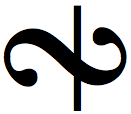The Turn - A Guide to Ornamentation
The Turn (German, Doppelschlag)
1.
The turn  divides the note over which it is placed (the principal note) into four notes: the note of the scale above, the principal note, the semitone below (see exceptions, below) and the principal note again. In quick time these notes should be equal, in moderate and slow time the last note should be longer than the others.
divides the note over which it is placed (the principal note) into four notes: the note of the scale above, the principal note, the semitone below (see exceptions, below) and the principal note again. In quick time these notes should be equal, in moderate and slow time the last note should be longer than the others.
2.
When either of the notes of the turn is to be accidentally raised or lowered, the necessary signs are invariably placed over, or under the turn sign.
3.
Sometimes these necessary signs are omitted, though obviously intended; the following rules help to suggest when this is the case:
4.
The under note of a turn is generally a semitone below the principal note, especially is this the case,
a)
When the turn is placed upon each note of a scale passage.
b)
When placed upon the fifth of the minor scale.
5.
The under note of a turn may be a tone below the principal note,
a)
When the turn is placed upon the second degree of the minor scale.
b)
When placed upon the raised seventh of the minor scale.
c)
When placed upon the third of the major scale.
d)
When placed upon the seventh of the major scale.
e)
When placed upon the second of the major scale followed by the key-note, or third of the scale.
6.
When the turn is placed over a note preceded by a rest, or staccato note, it should commence upon the principal note (not upon the note above), making a turn of five notes.
7.
When the turn is placed after a long note, the principal note lasts for nearly its full value, leaving just enough time for the turn at the end.
8.
When the turn is placed over, or after a dotted note, followed by a note of the value of a dot, completing the beat, or division of the beat, but not of the same pitch, the last note of the turn should take the place of the dot.
9.
When the turn is placed over a double dotted note, it should end on the first dot.
10.
When the turn is placed over, or after a dotted note, followed by a note of the value of the dot, and of the same pitch, it should be played as if the turn were placed over the second note.
11.
When the turn is placed over, or after a dotted note, followed by two short notes completing the beat, it should run on into the two notes without stopping on the dot.
12.
When the turn is placed over a note, preceded by one of the same pitch of twice or four times its value, it should be played before the note over which it is placed, even if the second note is dotted.
13.
When the turn is written out in full (in small type) it generally played in the same manner as when indicated by the usual sign  .
.
14.
When, in Baroque music, the turn is placed over a note, preceded by a note in small type of the same pitch, the turn commences upon the principal note, the small note is not struck.
15.
When the turn is placed over a note preceded by an appoggiatura, the first note of the turn is tied to the appoggiatura.
16.
When the turn is combined with the upper, or lower mordent, a turn of five notes is intended.
17.
The inverted turn consists of an exact reversal of the direct turn; it is indicated by  , but it is more often written in small notes.
, but it is more often written in small notes.
18.
Sometimes the student is puzzled by mistakes of notation, for instance, the following passage from Beethoven's Sonata, Op. 2, No. 3, first movement.
Also see Beethoven's Rondo in C, for the pianoforte, Op. 51, No. 1, wherin a similar passage occurs.


























